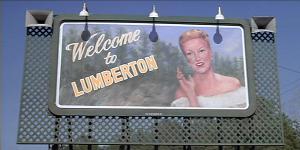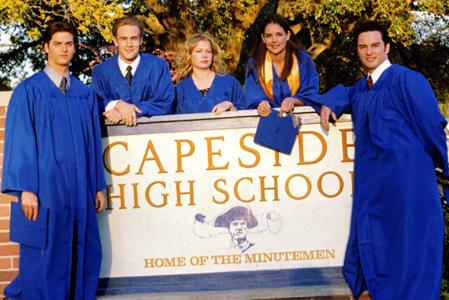 Dino De Laurentiis began his cinematic association with Wilmington when his company secured use of the Orton Plantation Home, 15 miles south of town, for use in 1984’s Firestarter. That same year, he purchased EUE/Screen Gems Studios in Wilmington (renaming it De Laurentiis Entertainment Group), while also overseeing the release of Dune, directed by David Lynch – who had signed with De Laurentiis to make a second, smaller picture. That followup film was Blue Velvet, which recast coastal Wilmington as the woodsy inland town of Lumberton. By day, Lumberton seems idyllic, with well-groomed lawns and friendly citizens smiling at young protagonist, Jeffrey Beaumont. By night, though, there emerges a sleazy underworld overseen by the sneering, gas-huffing madman, Frank Booth.
Dino De Laurentiis began his cinematic association with Wilmington when his company secured use of the Orton Plantation Home, 15 miles south of town, for use in 1984’s Firestarter. That same year, he purchased EUE/Screen Gems Studios in Wilmington (renaming it De Laurentiis Entertainment Group), while also overseeing the release of Dune, directed by David Lynch – who had signed with De Laurentiis to make a second, smaller picture. That followup film was Blue Velvet, which recast coastal Wilmington as the woodsy inland town of Lumberton. By day, Lumberton seems idyllic, with well-groomed lawns and friendly citizens smiling at young protagonist, Jeffrey Beaumont. By night, though, there emerges a sleazy underworld overseen by the sneering, gas-huffing madman, Frank Booth.  The shot of Jeffrey’s father suffering a stroke on his lawn finds the camera zooming closer and closer into the grass and earth – showing us the ravenous and malevolent insects who dwell just below the surface of Lumberton’s pristine daylight beauty. This echoes a bit of Wilmington’s own history. Today, the city bills itself as “Hollywood East,” and welcomes a wide variety of people working on film and television productions – yet back in 1898, a mob of white Wilmington residents attacked black citizens, deposed the integrated city government and imposed segregationist Jim Crow laws – achieving this nation’s only-ever municipal coup d’etat. 100 years later, in 1998,
The shot of Jeffrey’s father suffering a stroke on his lawn finds the camera zooming closer and closer into the grass and earth – showing us the ravenous and malevolent insects who dwell just below the surface of Lumberton’s pristine daylight beauty. This echoes a bit of Wilmington’s own history. Today, the city bills itself as “Hollywood East,” and welcomes a wide variety of people working on film and television productions – yet back in 1898, a mob of white Wilmington residents attacked black citizens, deposed the integrated city government and imposed segregationist Jim Crow laws – achieving this nation’s only-ever municipal coup d’etat. 100 years later, in 1998, Wilmington’s reputation was on the upswing with the television premiere of high school drama, Dawson’s Creek. Though the show was set in “Capeside,” Massachusetts, it was shot on sound stages at EUE/Screen Gems Studios (renamed by new owners), and around the Wilmington area. While the show ended in early 2003, new teen drama, One Tree Hill premiered that fall, taking over Dawson’s studio space – and even managing to set the action in (“Tree Hill”) North Carolina. Nicholas Sparks has set several novels in the Carolinas, including one with a star-crossed teen couple who stroll the magic hour streets of Wilmington (doubling here for Beaufort) in A Walk To Remember. Much less romantic, but even more juvenile are the adventures of one Kenny “Fuckin'” Powers, as a
Wilmington’s reputation was on the upswing with the television premiere of high school drama, Dawson’s Creek. Though the show was set in “Capeside,” Massachusetts, it was shot on sound stages at EUE/Screen Gems Studios (renamed by new owners), and around the Wilmington area. While the show ended in early 2003, new teen drama, One Tree Hill premiered that fall, taking over Dawson’s studio space – and even managing to set the action in (“Tree Hill”) North Carolina. Nicholas Sparks has set several novels in the Carolinas, including one with a star-crossed teen couple who stroll the magic hour streets of Wilmington (doubling here for Beaufort) in A Walk To Remember. Much less romantic, but even more juvenile are the adventures of one Kenny “Fuckin'” Powers, as a  down-on-his luck Major League pitcher coming home to Shelby, N.C. in Eastbound & Down. Though the first season was shot around Wilmington, season two finds Kenny in Mexico (OK, Puerto Rico) – depriving locals of the hero with a (self-described) “arm like a damn rocket, a cock like a Burmese python and the mind of a fuckin’ scientist.” Now, I dare Nicholas Sparks to write a novel around a character like that. Guaranteed, #1 best-seller. Anyway, EUE/Screen Gems Studios recently opened the country’s third largest sound stage (“Dream Stage 10”), housing one of the industry’s largest water tanks – and with its variety of well-preserved architecture (from antebellum, to industrial, to modern) and experienced film personnel, expect “Wilmywood” to continue playing the role of East Coast L.A.
down-on-his luck Major League pitcher coming home to Shelby, N.C. in Eastbound & Down. Though the first season was shot around Wilmington, season two finds Kenny in Mexico (OK, Puerto Rico) – depriving locals of the hero with a (self-described) “arm like a damn rocket, a cock like a Burmese python and the mind of a fuckin’ scientist.” Now, I dare Nicholas Sparks to write a novel around a character like that. Guaranteed, #1 best-seller. Anyway, EUE/Screen Gems Studios recently opened the country’s third largest sound stage (“Dream Stage 10”), housing one of the industry’s largest water tanks – and with its variety of well-preserved architecture (from antebellum, to industrial, to modern) and experienced film personnel, expect “Wilmywood” to continue playing the role of East Coast L.A.
2 minutes read
Wilmington, North Carolina
2 minutes read